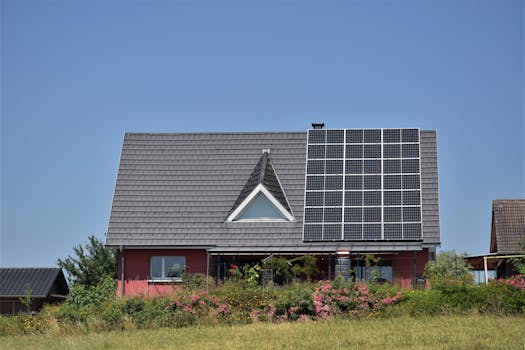“Powering Tomorrow: Unleashing the Future with Cutting-Edge Solar Innovations.”
Recent advances in solar panel technology have significantly enhanced the efficiency, affordability, and versatility of solar energy systems. Innovations such as bifacial solar panels, which capture sunlight on both sides, and perovskite solar cells, known for their high efficiency and lower production costs, are leading the way in improving energy output. Additionally, developments in solar tracking systems and integrated solar solutions, such as building-integrated photovoltaics (BIPV), are expanding the applications of solar energy in urban environments. These advancements not only contribute to a more sustainable energy future but also make solar power a more viable option for a broader range of consumers and industries.
Efficiency Improvements in Solar Cell Materials
Recent advancements in solar panel technology have significantly transformed the landscape of renewable energy, particularly through efficiency improvements in solar cell materials. As the global demand for clean energy continues to rise, researchers and manufacturers are relentlessly pursuing innovations that enhance the performance of solar cells. One of the most notable developments in this area is the emergence of perovskite solar cells, which have garnered attention for their remarkable efficiency and cost-effectiveness. Perovskite materials, characterized by their unique crystal structure, have demonstrated the ability to achieve efficiencies exceeding 25% in laboratory settings, rivaling traditional silicon-based solar cells.
Transitioning from traditional materials to perovskites has not only improved efficiency but also reduced production costs. The manufacturing process for perovskite solar cells is less energy-intensive compared to that of silicon cells, which often require high temperatures and complex fabrication techniques. This reduction in production costs is particularly significant for large-scale solar deployment, as it allows for more accessible and affordable solar energy solutions. Furthermore, the lightweight nature of perovskite materials opens up new possibilities for applications in various environments, including building-integrated photovoltaics and portable solar devices.
In addition to perovskites, researchers are exploring tandem solar cells, which combine different materials to capture a broader spectrum of sunlight. By stacking layers of solar cells made from different materials, such as silicon and perovskite, tandem cells can achieve efficiencies that surpass those of single-junction cells. This innovative approach not only maximizes energy conversion but also enhances the overall performance of solar panels under varying light conditions. As a result, tandem solar cells are becoming a focal point in the quest for higher efficiency, with ongoing research aimed at optimizing the materials and interfaces involved.
Moreover, advancements in nanotechnology have played a crucial role in improving solar cell efficiency. By manipulating materials at the nanoscale, scientists can enhance light absorption and reduce energy losses. For instance, the incorporation of nanostructures, such as quantum dots, can lead to better light trapping and increased charge carrier mobility. These enhancements contribute to higher overall efficiency and performance, making solar energy a more viable alternative to fossil fuels.
Another significant area of research involves the development of bifacial solar panels, which can capture sunlight from both sides. This design allows for increased energy generation, particularly in environments with reflective surfaces, such as snow or water. By harnessing additional sunlight, bifacial panels can improve the overall efficiency of solar installations, making them an attractive option for both residential and commercial applications.
As the solar industry continues to evolve, the integration of artificial intelligence and machine learning is also paving the way for efficiency improvements. These technologies can optimize the design and manufacturing processes of solar cells, enabling researchers to identify the most effective materials and configurations. By leveraging data-driven insights, manufacturers can streamline production and enhance the performance of solar panels, ultimately leading to more efficient energy generation.
In conclusion, the latest advances in solar panel technology, particularly in the realm of efficiency improvements in solar cell materials, are reshaping the future of renewable energy. With innovations such as perovskite cells, tandem configurations, nanotechnology, bifacial designs, and the integration of artificial intelligence, the potential for higher efficiency and lower costs is becoming increasingly attainable. As these technologies continue to develop, they promise to play a pivotal role in the global transition toward sustainable energy solutions.
Bifacial Solar Panels: Double the Power

In recent years, the solar energy sector has witnessed remarkable advancements, particularly with the introduction of bifacial solar panels, which are revolutionizing the way we harness solar power. Unlike traditional solar panels that capture sunlight from one side, bifacial panels are designed to absorb sunlight from both the front and the rear surfaces. This innovative design allows them to generate significantly more electricity, effectively doubling their power output under optimal conditions. As the demand for renewable energy sources continues to rise, understanding the benefits and functionalities of bifacial solar panels becomes increasingly important.
One of the key advantages of bifacial solar panels is their ability to utilize reflected sunlight, or albedo, from surrounding surfaces. For instance, when installed in areas with high reflectivity, such as snowy landscapes or light-colored rooftops, these panels can capture additional sunlight that would otherwise go unused. This characteristic not only enhances their efficiency but also makes them particularly suitable for diverse environments. As a result, bifacial panels can achieve energy yields that are 10 to 20 percent higher than their monofacial counterparts, depending on the installation conditions and the surrounding landscape.
Moreover, the durability and longevity of bifacial solar panels contribute to their growing popularity. Typically constructed with robust materials, these panels are designed to withstand harsh weather conditions, including hail, wind, and extreme temperatures. This resilience not only extends their lifespan but also reduces maintenance costs over time. As a result, investors and homeowners alike are increasingly inclined to adopt bifacial technology, recognizing its potential for long-term energy savings and reliability.
Transitioning to the installation aspect, bifacial solar panels can be integrated into various mounting systems, including fixed tilt and tracking systems. Tracking systems, which follow the sun’s path throughout the day, can further enhance the energy output of bifacial panels by maximizing their exposure to sunlight. This adaptability makes bifacial technology an attractive option for both residential and commercial applications, as it can be tailored to meet specific energy needs and site conditions.
In addition to their technical advantages, bifacial solar panels also align with the growing emphasis on sustainability and environmental responsibility. As the world grapples with climate change and the need for cleaner energy sources, the increased efficiency of bifacial panels contributes to a more sustainable energy landscape. By generating more power from the same amount of sunlight, these panels help reduce the overall carbon footprint associated with energy production. Consequently, they play a vital role in the transition towards a greener future.
Furthermore, as research and development in solar technology continue to advance, the cost of bifacial solar panels is gradually decreasing. This trend is making them more accessible to a broader range of consumers and businesses, thereby accelerating their adoption in the market. With ongoing innovations in materials and manufacturing processes, the efficiency and affordability of bifacial panels are expected to improve even further, solidifying their position as a leading choice in solar energy solutions.
In conclusion, bifacial solar panels represent a significant leap forward in solar technology, offering enhanced efficiency, durability, and sustainability. As they capture sunlight from both sides, they not only maximize energy production but also contribute to a more environmentally friendly energy landscape. With their growing popularity and decreasing costs, bifacial solar panels are poised to play a crucial role in the future of renewable energy, making them an essential consideration for anyone looking to invest in solar power.
Innovations in Solar Panel Recycling
As the demand for renewable energy sources continues to rise, the focus on solar panel technology has expanded beyond just efficiency and production. An increasingly critical area of innovation is solar panel recycling, which addresses the environmental concerns associated with the disposal of solar panels at the end of their life cycle. With the global solar market projected to grow significantly, the need for effective recycling solutions has never been more pressing. Recent advances in this field are paving the way for a more sustainable approach to solar energy.
One of the most notable innovations in solar panel recycling is the development of advanced mechanical processes that can efficiently separate the various materials used in solar panels. Traditional recycling methods often struggled with the complex composition of solar panels, which typically include glass, silicon, metals, and polymers. However, new mechanical techniques have emerged that utilize shredding and air classification to effectively separate these materials. This not only increases the recovery rates of valuable components but also reduces the energy required for processing, making the recycling process more environmentally friendly.
In addition to mechanical advancements, chemical recycling methods are gaining traction. These methods involve using solvents or chemical reactions to break down the materials in solar panels, allowing for the recovery of high-purity silicon and other valuable elements. This approach is particularly beneficial for thin-film solar panels, which have different compositions compared to traditional crystalline silicon panels. By employing chemical recycling, companies can ensure that a higher percentage of materials is recovered and reused, thus minimizing waste and reducing the need for virgin materials in new panel production.
Moreover, the integration of artificial intelligence (AI) and machine learning into the recycling process is revolutionizing how solar panels are processed. AI algorithms can analyze the composition of solar panels and optimize the recycling process by predicting the most efficient methods for material recovery. This not only enhances the overall efficiency of recycling operations but also allows for real-time monitoring and adjustments, ensuring that the process remains as effective as possible. As these technologies continue to evolve, they hold the potential to significantly improve the economics of solar panel recycling, making it a more viable option for manufacturers and consumers alike.
Another important aspect of innovation in solar panel recycling is the establishment of closed-loop systems. These systems aim to create a circular economy for solar panels, where materials recovered from old panels are reintegrated into the production of new panels. Companies are increasingly collaborating with manufacturers to develop take-back programs that facilitate the return of end-of-life panels for recycling. This not only helps to ensure that valuable materials are reused but also fosters a sense of responsibility among consumers and manufacturers regarding the lifecycle of solar products.
Furthermore, regulatory frameworks are beginning to catch up with these technological advancements. Governments around the world are recognizing the importance of sustainable practices in the solar industry and are implementing policies that encourage recycling and responsible disposal of solar panels. These regulations not only promote innovation but also create a market for recycled materials, further incentivizing companies to invest in recycling technologies.
In conclusion, the latest advances in solar panel recycling are crucial for the sustainable growth of the solar energy sector. By improving mechanical and chemical recycling processes, leveraging AI technologies, and fostering closed-loop systems, the industry is taking significant steps toward minimizing waste and maximizing resource recovery. As these innovations continue to develop, they will play a vital role in ensuring that solar energy remains a clean and sustainable solution for the future.
The Rise of Transparent Solar Technologies
The rise of transparent solar technologies marks a significant advancement in the field of renewable energy, offering innovative solutions that blend seamlessly into our everyday environments. As the demand for sustainable energy sources continues to grow, researchers and engineers have been exploring ways to integrate solar energy generation into existing structures without compromising aesthetics or functionality. Transparent solar panels, which can be applied to windows and other surfaces, represent a promising avenue for harnessing solar power while maintaining the visual appeal of buildings and urban landscapes.
One of the most exciting aspects of transparent solar technologies is their potential to transform ordinary surfaces into energy-generating assets. Traditional solar panels, while effective, often require dedicated space that can detract from the architectural integrity of a building. In contrast, transparent solar cells can be incorporated into windows, facades, and even mobile devices, allowing for energy generation in locations that were previously considered unsuitable for solar applications. This integration not only maximizes energy capture but also enhances the overall efficiency of buildings by reducing reliance on conventional energy sources.
Recent advancements in materials science have played a crucial role in the development of transparent solar technologies. Researchers have been experimenting with organic photovoltaic materials and perovskite solar cells, which can be engineered to allow visible light to pass through while still capturing ultraviolet and infrared wavelengths for energy conversion. This dual functionality is essential, as it enables the creation of windows that do not obstruct natural light while simultaneously generating electricity. As a result, buildings can become self-sustaining energy producers, contributing to a reduction in carbon footprints and energy costs.
Moreover, the versatility of transparent solar technologies extends beyond buildings. For instance, they can be applied to vehicles, allowing car windows to generate power while driving or parked. This innovation could lead to significant improvements in electric vehicle efficiency, as the energy harvested from the sun could be used to power onboard systems or recharge batteries. Additionally, the potential for transparent solar panels to be integrated into consumer electronics, such as smartphones and tablets, opens up new possibilities for portable energy solutions. Imagine a smartphone that charges itself simply by being exposed to sunlight, enhancing convenience and reducing the need for frequent charging.
Despite the promising developments in transparent solar technologies, challenges remain. The efficiency of these solar cells is generally lower than that of traditional opaque panels, which can limit their widespread adoption. However, ongoing research is focused on improving the efficiency and cost-effectiveness of transparent solar technologies, making them more competitive in the renewable energy market. As innovations continue to emerge, it is likely that we will see significant improvements in performance, paving the way for broader implementation.
In conclusion, the rise of transparent solar technologies represents a transformative shift in how we think about solar energy generation. By integrating these innovative solutions into our built environment, we can harness the power of the sun without sacrificing aesthetics or functionality. As research progresses and efficiency improves, transparent solar panels have the potential to revolutionize energy consumption in urban settings, making sustainable energy more accessible and practical for everyday use. The future of solar energy is bright, and transparent technologies are at the forefront of this exciting evolution.
Q&A
1. **Question:** What is bifacial solar panel technology?
**Answer:** Bifacial solar panels can capture sunlight from both sides, increasing energy generation by up to 30% compared to traditional monofacial panels.
2. **Question:** How have perovskite solar cells advanced in recent years?
**Answer:** Perovskite solar cells have seen significant improvements in efficiency and stability, with some achieving over 25% efficiency and demonstrating better performance in low-light conditions.
3. **Question:** What role does solar tracking technology play in solar energy production?
**Answer:** Solar tracking technology allows panels to follow the sun’s path, optimizing the angle of incidence and increasing energy output by 20-50% compared to fixed installations.
4. **Question:** How are transparent solar panels being developed?
**Answer:** Transparent solar panels are being engineered to function as windows while generating electricity, using materials that allow visible light to pass through while capturing ultraviolet and infrared light for energy conversion.
Conclusion
Recent advances in solar panel technology have significantly improved efficiency, affordability, and sustainability. Innovations such as bifacial panels, perovskite solar cells, and enhanced energy storage solutions have led to higher energy conversion rates and reduced costs. Additionally, developments in recycling methods for solar panels are addressing environmental concerns, making solar energy a more viable and eco-friendly option. Overall, these advancements are driving the growth of solar energy adoption, contributing to a more sustainable energy future.




